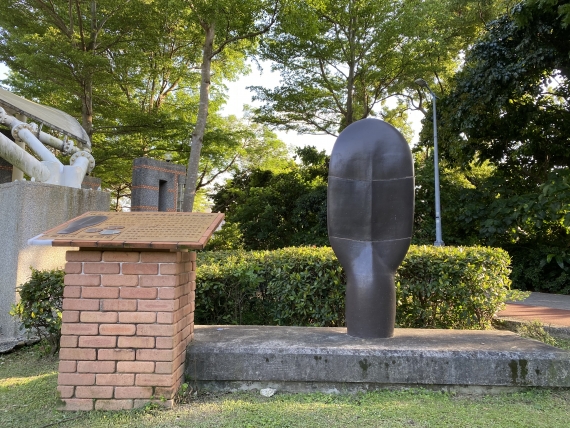A Potential Archeological Site of Shiwufen

Jingmei Sports Park, located at the end of Jingfeng Street, is where Yee Fong Chemical Corporation was previously based. After the firm relocated, part of its former site was expropriated to build the park. On the left of a hill, what appears to be the archeological site of Shiwufen from the Yuanshan Culture of the late Neolithic age or the Botanical Garden Culture of the early Neolithic age (dating back to 2000–2500 years ago) has been discovered. Stone implements excavated in this site include six Patu-shaped stone axes and 19 net sinkers. These artifacts were unearthed on Arbor Day of 1986, when local residents were planting trees behind a house. For various reasons and through his personal connections, Cheng Ching-lung, a long-time student of Wenshan Community College, was given a stone implement by his friend, and he sent a photo of the artifact in October 2006 to Prof. Liu Yi-Chang of the Institute of History and Philology of Academia Sinica. After examining the photo, Prof. Liu inferred that the artifact is part of the archeological site of Shiwufen from the Botanical Garden Culture of the early Neolithic age more than 2000 years ago. Later on, the college applied to the Department of Cultural Affairs of Taipei City Government to have the digs recognized. On September 7, 2007, a group of archeologists and government officials commissioned by the department inspected the site, but could not date it exactly because the precise location where it was excavated could not be ascertained and no potsherd evidence was available. As a result, it was recognized as a “potential archeological site of Shiwufen” and has yet been registered as a heritage site or assigned any grade for this.
The archeological site of Shiwufen was first discovered in 1928 (the 3rd year of the Showa era), when earth was excavated from Shiwufen Village to fill the land of the newly established Taihoku Imperial University (nowadays National Taiwan University). The stone implements dug out from the site were then studied by Prof. Nenozo Utsurikawa, an ethnologist, who concluded that they were the Patu-shaped stone tools used by the Maori in New Zealand. These artifacts were the first find of Patu-shaped stone tools in Taiwan. Prof. Utsurikawa would present a research paper in 1934 to discuss the artifacts, thereby ushering in the cultural exchange between Austronesian-speaking peoples in the pan-Pacific region. After Japanese left Taiwan at the end of World War II, the exact location of the archeological site was nowhere to be found. However, through many years of hard work from the public in general, the local cultural authorities erected a “monument for artifacts from the potential archeological site of Shiwufen” in May 2015. Near the monument you can see an inscription carved out of ceramics and a 162 cm-tall Patu replica fired from clay. Jingmei Sports Park is also expected to be renamed “Shiwufen Archeological Site Park,” so that many more can get to know this piece of heritage.

最新自 何文賢 / He Wen-hsien
- 1960年代的景美菜市場
- 己亥年(108年)景美聯合遶境
- 壬辰年(民國101年)景美集應廟迎香慶典
- 壬辰年(民國101年)景美聯合遶境慶典
- 文山興安宮
- 古亭地政事務所
- 未有大樓前的景美街景
- 由景文街看車前路
- 車前路地貌的改變
- 辛卯年(民國100年)北投集應廟至景美迎回保儀
- 原車前路上順泰玩具食品行
- 高選風遺墨
- 景文街林鶴年醫院舊宅
- 景美集應廟豬公祭典(一)
- 景美舊橋封橋待拆除
- 開道碑重置揭幕
- 瑠公圳舊道與新道會合點
- 興隆市場
- 1970年以前景美的工廠及公營機構
- 1980年以後景美的工廠及公營機構
- Liugong Bridge: the First Reinforced-Concrete Bridge in Taiwan
- Expected Changes for the Landscape of Jingmei After 2020
- Landscape of Jingmei during 2000–2020
- Landscape of Jingmei during 1980–2000
- Landscape of Jingmei during 1960–1980
- Landscape of Jingmei before 1960
- The Stealthy Wansheng River
- Turning Jingmei River Channels into Parks
- Xingfu Village Monument
- Earth God Temple in Jingmei
- History of Wan-Xin Railway
- Liugongjun and Wooden Trough Bridge
- History of Jingmei Bridge
- Coal Mining in Wenshan District
- Important Infrastructures in Wenshan District from the Past
- Changes in Jingmei’s Geography and Road Infrastructure
- History of Jingmei
- 霧裡薛圳圳路
- 景美街1號與2號距離遠
- 景美行政變遷
- 景美老街拱形騎樓元素
- 都更下的景美街困境
- 2000年至2020年景美地景變遷
- 1960年以前景美地景樣貌
- 1960年至1980年景美地景變遷
- 1980年至2000年景美地景變遷
- 2020年後景美地景變遷的期待
- 景美街商業土地使用分區
- 原貌仍在的泰興染織廠
- 中農化工廠基地變遷
- 1980年以後景美的工廠及公營機構
- 1970年以前景美的工廠及公營機構
- 興福庄「建塚記念碑」
- 金獎外觀興隆市場
- 臺北花木批發市場
- 疑似十五份遺址
- 會元洞清水祖師廟
- 景美福興宮
- 景美瑠公圳暨成巷道
- 景美忠勤三莊新面向
- 景美「賴氏萬壽塔」
- 頂公館福德宮
- 消失的興福庄浚溝修路石碑
- 和伯公紀念會館
- 台北江西會館及萬壽宮
- 在興隆路的台北畜產運銷公司
- 在景美的古亭地政事務所
- 文山興安宮
- 文山溪洲福德宮
- 三福街古道
- 十五分火車站
- 十五分庄舊地名
- 木柵集應廟保儀尊王巡境貓空
- 甲午年(103)木柵集應廟巡境慶典
- 景美集應廟豬公祭典
- 仙跡岩拾遺
- 仙跡岩的民間信仰
- 仙跡岩舊八景
- 龍吃水的地理景觀
- 圳後山的圖根點
- 景美山的三角點
- 百年金龜樹生病了
- 景美其他的老樹
- 景行公園的老樹
- 景美養工處老樹
- 巷內的魯花樹
- 興安宮的老榕樹
- 景豐街的老樹
- 萬有公園的老樹
- 萬和公園的老樹
- 景美國中的老樹
- 景美國小附近老樹
- 景美國小的老樹
- 萬新鐵路的歷史
- 景美聖方濟沙勿略堂
- 景美的西方教會彙總
- 味自慢居酒屋
- 義興樓食堂
- 景美的春燕
- 萬盛溪舊溪床旁的春燕


